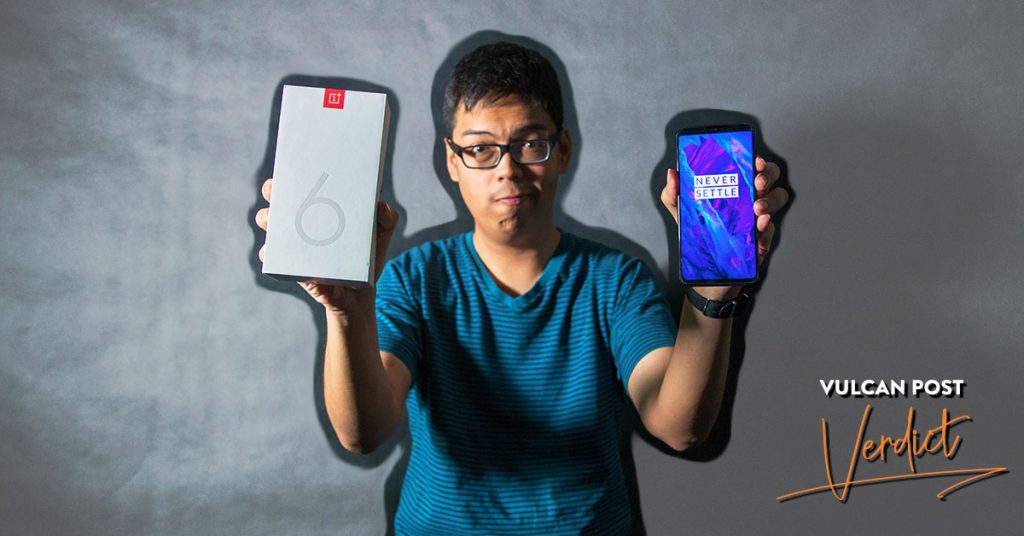- The OnePlus 6 was announced and released in May 2018, taking its place as the Chinese manufacturer’s newest flagship product.
- Starting at an official price point of around RM2,399, the OnePlus 6 manages to pack in many high end components found on other much more expensive flagships.
Within the span of about 4 to 5 years, OnePlus has forged a name for itself as yet another Chinese brand to watch. Over recent years, the company from Shenzhen managed to accumulate a loyal customer base following smartphone releases are known to provide value comparable to other flagship phones, without the much higher pricetags.
The OnePlus 6 is no exception. Announced and released in May this year, the budget flagship manages to include many components found in rival flagships that cost nearly RM1,000 more. So when the chance for us to review the phone came along, I grabbed at it with both hands.
Here’s what I thought.
|
Hardware Specs |
|
| Display | 6.28 inch AMOLED panel, 1080 x 2280 pixels, 19:9 |
| Dimensions & Weight | 155.7 x 75.4 x 7.8 mm (6.13 x 2.97 x 0.31 in), 177 grams |
| Camera | Dual Rear Camera: 16MP primary shooter + 20MP portrait mode camera
Front: 16MP |
| Processor | Qualcomm Snapdragon 845 |
| Memory | Available in 6GB or 8GB |
| Storage | 64GB/128GB/256GB, no expandable storage |
| Battery | 3,300 mAh |
Hardware
On the hardware side of things, the OnePlus 6 falls in line with the rest of today’s flagships by incorporating a full glass enclosure, with Gorilla Glass 5 sandwiching the internals and providing a nice heftiness to the overall hand feel.
This model came with a Mirror Black finish—one of 4 finishes currently available on the market (not including the limited Avengers version), and was an outright fingerprint magnet. You’ll definitely want to use the included jelly case when carrying the phone around.

Other expected flagship features include the dual camera, with OnePlus opting to implement this using the primary 16-megapixel shooter for standard photo-taking and the secondary 20-megapixel lens purely for portrait mode.
And like many other phones released this year, the OnePlus 6 also has a notch. For better or for worse, this notch serves to increase screen real estate, with notification icons all bumped up to sit beside that small black expanse instead of the usual spot below the selfie camera and call speakers.
OnePlus however did manage to include the option of turning off the notch in the settings, meaning that users who prefer a more traditional look can opt to black out the background of the areas beside the notch.
The phone also touts a degree of water resistance, and although I was a bit disappointed that they decline to attach a full IP67 or IP68 resistance rating to the device, I understood that this was done as a purely business decision—water resistance ratings can be costly to acquire.
User Experience
Over a month using the OnePlus 6, I can confidently say that the phone puts out a performance fully befitting the title of a true flagship. This is hardly surprising, as my version of the device carried Qualcomm’s latest Snapdragon 845, 8GB of RAM, and 128GB of storage.
Translating into real-world performance, the OnePlus 6 blitzes through apps and games with ease, its speediness only amplified by the high end processing and also the lightness of Oxygen OS—a skin that’s incredibly close to being stock Android with the exception a few thoughtful additions.
These additions, while minor, all add up to be another plus point in the user experience department.
For example, OnePlus automatically includes an optional Dark Mode that turns system menus black instead of white, helping users save on battery usage. They’ve also included the ever-convenient off-screen gestures that allow you toggle various phone functions by drawing on the screen while off (for example, I would turn my flashlight on and off by drawing ‘W’).
This all ties in nicely with the OnePlus 6’s more than adequate 3,300 mAh battery. On average, the OnePlus 6 was able to provide me a full day of juice with heavy YouTube viewing, gaming, and music listening, and for moderate use, I was able to derived a day and a half with about 10% left to spare.
Where refuelling is concerned, the OnePlus 6 does not have wireless charging, which is a bit of a curious letdown considering their decision to include a glass back (although they have explained that the primary reason for a full glass enclosure was to ensure faster data speeds).
But the inclusion of their Dash Charging cable more than makes up for this absence, allowing the phone to reach full capacity within approximately an hour, effectively making this one of the quickest charging phones around provided you use the supplied power plug and cable.
Camera
It’s in the camera setup where the slight disadvantage of OnePlus being a relatively small phone manufacturer rears its head. Compared to the iPhones, Google Pixels, Samsung Galaxies, and Huawei P20s of the world, the OnePlus 6 manages to offer up a photographic performance that could be considered good but not outstanding.
The dual camera setup was able to take on most photo tasks competently, and the quality of all of its shots turned out very colour-accurate with well-defined white balance and edges. The camera also did pretty great with edge detection on portrait mode and was able to manage video pretty splendidly.

But it’s with low-light shots where the OnePlus 6 lagged behind its peers. Compared to other flagships from companies with more resources to devote to camera technology, the OnePlus 6 found itself slightly wanting when it came to shots at night or in dimly lit places.
Not that photos taken in these situations were bad—they were actually pretty good-looking—but it was obvious that the OnePlus 6 lagged behind in the dynamic range department and exposure compared to phones like the Huawei P20 Pro or Samsung Galaxy S9+ (which costs nearly a grand more).

But even with this aspect being not as great as the overall experience, there was absolutely nothing to complain about. I surmised that for everyday users who want a point-and-shoot camera, the OnePlus 6 more than fulfills that need.
Verdict
Rounding up all facets of the OnePlus 6 experience, I can only say that I was more than happy to carry it around as my daily driver.
While it obviously lacks some nice features such as wireless charging, expandable storage, or a world-beating camera setup, the OnePlus 6 more than makes up for these flaws by including a highly optimised user experience as well as other creature comforts such as the 3.5mm headphone jack and even a notification slider that makes it easy to switch between ringing, vibrate, and completely silent modes.

All things considered, the OnePlus 6 is a more than solid choice for anyone in the market for a gimmick-free top-notch performer.
Sure, the value proposition might not be as strong compared to its predecessors, but a phone that stands toe-to-toe with the very best flagships at nearly RM1k cheaper can only be considered nothing short of a winner.
- The OnePlus 6 currently retails at an official price point of around RM2,399.
VP Verdicts is a series where we personally try and test out products, services, fads, and apps. Want to suggest something else for us to try? Leave a comment here or send the suggestion into our Facebook page.




















